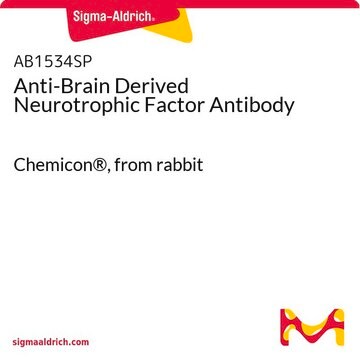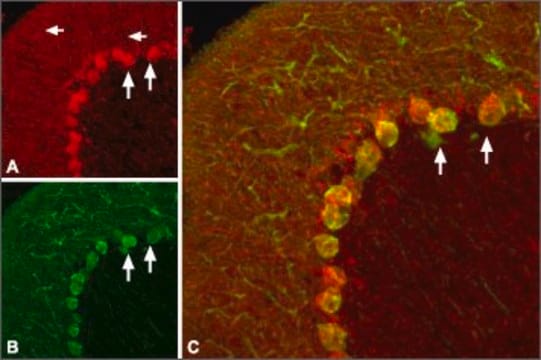AB1779
Anti-Brain Derived Neurotrophic Factor Antibody
serum, Chemicon®
Synonym(s):
BDNF
Sign Into View Organizational & Contract Pricing
All Photos(1)
About This Item
UNSPSC Code:
12352203
eCl@ss:
32160702
NACRES:
NA.41
Recommended Products
biological source
rabbit
Quality Level
antibody form
serum
antibody product type
primary antibodies
clone
polyclonal
species reactivity
human, rat
manufacturer/tradename
Chemicon®
technique(s)
immunohistochemistry: suitable
western blot: suitable
NCBI accession no.
UniProt accession no.
shipped in
wet ice
target post-translational modification
unmodified
Gene Information
human ... BDNF(627)
Specificity
Brain Derived Neurotrophic Factor (BDNF). By dot blot, less than 1% cross-reactivity against NGF, NT3 or NT4.
SPECIES REACTIVITIES: Rat and human. Other species not yet tested. It is likely that the antibody will also work on mouse and porcine due to sequence homology.
SPECIES REACTIVITIES: Rat and human. Other species not yet tested. It is likely that the antibody will also work on mouse and porcine due to sequence homology.
Immunogen
Recombinant Human Brain Derived Neurotrophic Factor (BDNF).
Application
Detect Brain Derived Neurotrophic Factor using this Anti-Brain Derived Neurotrophic Factor Antibody validated for use in WB, IH.
Immunohistochemistry: 1:1,000 (see suggested protocol).
Immunoblotting:1:1,000; we recommend preparing the BDNF samples for western blot by the method of Katoh-Semba (1997) because BDNF is not easily extracted in standard buffers. Dissected tissues should be homogenized in 10 volumes of 100mM phosphate buffer containing 1mM EDTA, 2M guanidine hydrochloride (pH7.2), and three protease inhibitors, 10mM N-ethylmaleimide, 0.36mM pepstatin, and 1mM PMSF. Homogenates are then sonicated and centrifuged at 46K x g for 30 minutes at 4C.
BIOLOGICAL ACTIVITY: Neutralizes BDNF, but not other neurotrophins.
Optimal working dilutions must be determined by end user.
Immunoblotting:1:1,000; we recommend preparing the BDNF samples for western blot by the method of Katoh-Semba (1997) because BDNF is not easily extracted in standard buffers. Dissected tissues should be homogenized in 10 volumes of 100mM phosphate buffer containing 1mM EDTA, 2M guanidine hydrochloride (pH7.2), and three protease inhibitors, 10mM N-ethylmaleimide, 0.36mM pepstatin, and 1mM PMSF. Homogenates are then sonicated and centrifuged at 46K x g for 30 minutes at 4C.
BIOLOGICAL ACTIVITY: Neutralizes BDNF, but not other neurotrophins.
Optimal working dilutions must be determined by end user.
Research Category
Neuroscience
Neuroscience
Research Sub Category
Neurochemistry & Neurotrophins
Neuroinflammation & Pain
Neurochemistry & Neurotrophins
Neuroinflammation & Pain
Physical form
Lyophilized, no preservatives. Reconstitute with 50 μL of sterile distilled water.
Storage and Stability
Maintain lyophilized material at -20 to -70°C for up to 12 months. After reconstitution maintain at -20°C in undiluted aliquots for up to 6 months. Avoid repeated freeze/thaw cycles. Glycerol (1:1) can be added for additional stability.
Legal Information
CHEMICON is a registered trademark of Merck KGaA, Darmstadt, Germany
Disclaimer
Unless otherwise stated in our catalog or other company documentation accompanying the product(s), our products are intended for research use only and are not to be used for any other purpose, which includes but is not limited to, unauthorized commercial uses, in vitro diagnostic uses, ex vivo or in vivo therapeutic uses or any type of consumption or application to humans or animals.
Not finding the right product?
Try our Product Selector Tool.
recommended
Product No.
Description
Pricing
Storage Class Code
10 - Combustible liquids
Certificates of Analysis (COA)
Search for Certificates of Analysis (COA) by entering the products Lot/Batch Number. Lot and Batch Numbers can be found on a product’s label following the words ‘Lot’ or ‘Batch’.
Already Own This Product?
Find documentation for the products that you have recently purchased in the Document Library.
Monica A Maldonado et al.
Neurorehabilitation and neural repair, 22(3), 250-261 (2007-12-13)
Exercise and rehabilitative training each have been implicated in the promotion of restorative neural plasticity after cerebral injury. Because motor skill training induces synaptic plasticity and exercise increases plasticity-related proteins, we asked if exercise could improve the efficacy of training
Fenghua Chen et al.
The international journal of neuropsychopharmacology, 21(6), 603-615 (2018-03-08)
Preclinical studies have indicated that antidepressant effect of vortioxetine involves increased synaptic plasticity and promotion of spine maturation. Mitochondria dysfunction may contribute to the pathophysiological basis of major depressive disorder. Taking into consideration that vortioxetine increases spine number and dendritic
Ryan G Soderquist et al.
Journal of biomedical materials research. Part A, 91(3), 719-729 (2008-12-03)
Brain-derived neurotrophic factor (BDNF) was covalently attached to polyethylene glycol (PEG) in order to enhance delivery to the spinal cord via the cerebrospinal fluid (intrathecal administration). By varying reaction conditions, mixtures of BDNF covalently attached to one (primary), two (secondary)
Tom Verhovshek et al.
Developmental neurobiology, 73(8), 587-598 (2013-03-21)
We have previously demonstrated that brain-derived neurotrophic factor (BDNF) interacts with testosterone to regulate dendritic morphology of motoneurons in the highly androgen-sensitive spinal nucleus of the bulbocavernosus (SNB). Additionally, in adult male rats testosterone regulates BDNF in SNB motoneurons and
Fenghua Chen et al.
The international journal of neuropsychopharmacology, 21(3), 291-304 (2017-12-12)
Electroconvulsive therapy is a fast-acting and efficient treatment of depression used in the clinic. The underlying mechanism of its therapeutic effect is still unclear. However, recovery of synaptic connections and synaptic remodeling is thought to play a critical role for
Our team of scientists has experience in all areas of research including Life Science, Material Science, Chemical Synthesis, Chromatography, Analytical and many others.
Contact Technical Service








